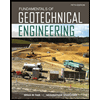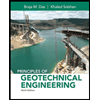
Concept explainers
(a)
Find the void ratio of soil specimen.
(a)
Answer to Problem 2.1P
The void ratio of soil is 0.76.
Explanation of Solution
Given information:
The mass (m) of the soil is
The volume (v) of the soil is
The moisture content (w) is 15%.
The specific gravity
Calculation:
Consider the unit weight of water
Calculate the moist unit weight of the soil
Calculate the dry unit weight of the soil
Calculate the void ratio (e) using the relation as shown below:
Hence, the void ratio of soil is 0.76.
(b)
Calculate the porosity of soil.
(b)
Answer to Problem 2.1P
The porosity of soil is
Explanation of Solution
Calculation:
Refer to part (a).
The void ratio of soil is
Calculate the void ratio
Substitute
Hence, the porosity of soil is
(c)
Calculate the dry unit weight of soil.
(c)
Answer to Problem 2.1P
The dry unit weight of soil is
Explanation of Solution
Calculation:
Calculate the dry unit weight of the soil
Refer to part (a).
Base on result, the dry unit weight of the soil is
Thus, the dry unit weight of soil is
(d)
Calculate the moist unit weight of soil.
(d)
Answer to Problem 2.1P
The moist unit weight of soil is
Explanation of Solution
Calculation:
Calculate the moist unit weight of the soil
Refer to part (a).
Base on result, the dry unit weight of the soil is
Thus, the moist unit weight of soil is
(e)
Calculate the degree of saturation.
(e)
Answer to Problem 2.1P
The degree of saturation is
Explanation of Solution
Calculation:
Refer to part (a).
The void ratio of soil is
Calculate the degree of saturation
Hence, the degree of saturation is
Want to see more full solutions like this?
Chapter 2 Solutions
EBK PRINCIPLES OF FOUNDATION ENGINEERIN
- Given the monthly resilient modulus below, find out relative damage of each month, the average relative damage and the effective roadbed resilient modulus.Month Resilient Modulus (psi):Jan 20,000Feb 22,000March 5,000April 6,000May 7,000June 8,000July 8,500August 9,500September 9,000October 8,000November 7,000December 18,000arrow_forwardDetermine the largest torque T that can be applied to each of the twoaluminium bars shown in Figure 5 below, and the corresponding angle of twistat B, knowing that allow = 50 MPa and G = 26 GPa. [10]Figure 5 : Aluminium Bars(Source: Mechanics of Materials Beer, Johnston, DeWolf & Mazurek 6Ed p204)arrow_forwardAssume a car park facility where the arrival rate is λ customer every minute, and the service process including pressing the button, taking the card, and waiting for the boom to rise leads to service rate of μ customer every minute. a. Assume the arrival and service processes are stochastic. Using any software (Excel, Matlab, or the one you prefer), plot average delay time (including service time) and average queue size (including the vehicle currently being served) for all combinations of λ = {1,2,3,..,10} and p = {0.1,0.3,0.5,0.7,0.9}. Specifically, we ask you to make 2 graphs (one for average delay and the other for average queue size), where the x-axes contains the different values for 1, and where you make one curve for each p. b. Assume the arrival process is stochastic but the service process is deterministic with rate µ. Using any software (Excel, Matlab, or the one you prefer), plot average delay time (including service time) and average queue size (including the vehicle…arrow_forward
- Consider, M people (aka pax) who want to travel by car from O to D. They all start working at D at Q (e.g., Q-8am). If a person departs at time t, assume the time needed to go from O to D is given by c(t)=A+Bx(t), where x(t) is the flow of people departing at time t [car/unit of time]. In addition, a is the penalty for being early at work (E(t) is how early the person arrived when departing at time t), and ẞ is the penalty for being late at work (L(t) is how late the person arrived when departing at time t). Assume 0 < a < 1 < ß. Further assume the departure time choice problem under the equilibrium conditions. Prove that the arrival time of people who depart when most of the M people start their trips is equal to Q.arrow_forwardConsider, M people (aka pax) who want to travel by car from O to D. They all start working at D at Q (e.g., Q=8am). If a person departs at time t, assume the time needed to go from O to D is given by c(t)=A+Bx(t), where x(t) is the flow of people departing at time t [car/unit of time]. In addition, a is the penalty for being early at work (E(t) is how early the person arrived when departing at time t), and ẞ is the penalty for being late at work (L(t) is how late the person arrived when departing at time t). Assume 0 < a < 1 < ß. Further assume the departure time choice problem under the equilibrium conditions. Prove that the arrival time of people who depart when most of the M people start their trips is equal to Q.arrow_forward1. Plot the SWRC (suction vs. volumetric water content) from the van Genuchten (1980) model for the following “base-case” parameters (assume m = 1-1/nvG): alpha vG = 0.35 kPa-1, nvG = 2.2,Delta res = 0.02, and delta S = delta sat = 0.45. These values are approximately representative of a sand.Perform a sensitivity analysis on each of the base case parameters (i.e., vary each by ±10% while holding the other three constant) to determine their relative effects on the SWRC. For example, how would a change in s alter the curve if the other base case parameters stay the same? In your answer, provide 4 plots for the parametric evaluation of each parameter as well as a brief qualitative explanation for each plot (for example, when investigating the effect of alpha vG, show the base-case curve and the curves with different values of alpha vG on the same plot). Be sure that suction is plotted on a logarithmic scale. Also, discuss how theparameters of the van Genuchten SWRC model might differ…arrow_forward
- Using AutoCAD and exact measure that numberarrow_forwardA fully grouted reinforced masonry wall is to be constructed of 8-in. CMU. The wall height is 18feet. It is assumed to be simply supported. The wall is to be designed for an out-of-plane seismicload of 52 lbs./ft.2, which can act in either direction. The wall also supports a roof dead load of600 lbs./ft. and a roof live load of 300 lbs./ft. along the wall length. The roof loads have aneccentricity of 2.5 inches. Since there is seismic load, load combinations (6) and (7) in Chapter 2of ASCE 7-22 should be considered. In these two load combinations,horizontal seismic loadhE =andvertical seismic loadvE = . You may ignorevE in this problem for simplicity. The masonryhas a specified compressive strength of 2,500 psi. (a) Use the strength design provisions of TMS402 to determine the size and spacing of the vertical bars needed. Use the P-δ analysis method inSection 9.3.4.4.2 of TMS 402 to determine Mu. (b) Repeat the design using the momentmagnification method in Section 9.3.4.4.3 instead.…arrow_forwardThe city's downtown area on Elm St, with its intricate network of roads and intersections, has long been a challenge for both seasoned travelers and newcomers alike. Given the lane configurations for the shown intersection, find the number of conflict points. Vehicle-to-vehicle conflicts (merge, diverge, and/or crossing conflicts) Vehicle-to-pedestrian conflicts Vehicle-to-bicycle conflictsarrow_forward
- Can you please do hand calcs and breakdown each steparrow_forwardQ4. Statically determinate or indeterminate frame analysis by the stiffness method a) Determine the stiffness matrix of the frame as shown in Fig. 4. Nodes 1 and 3 are fixed supports. Assume I = 300(10%) mm, A = 10(103) mm², E = 200 GPa for each member. Indicate the degrees-of freedom in all the stiffness matrices. Use the values of L3-3.5 m, w = 24 kN/m and P = 30 kN. Note, L4-1.8L3 (i.e. 1.8 times L3). b) Determine all the displacement components at node 2 and all internal reactions at node 2. Show all calculations. c) Draw the BMD of the frame on the compression side showing all the salient values. Show all calculations. d) Repeat the problem using the Strand 7. Show the model with all the nodes and element numbers and boundary conditions. Submit a hard copy from Strand7 showing all the reactions (highlight these in the hard copy). Display the bending moment diagram for the frame. 4 e) Compare the BMD from Strand 7 with the theoretical one and compare the respective values of…arrow_forwardCan you please break down all the hand calcs and make sure we answer the below. a Determine the global stiffness matrices (k’) of all truss members including correct degrees-of freedom (dof)-3x3 b Determine the global stiffness matrix (K) of the whole truss (include dof numbers) c i) Calculate vectors D and Q (4+4). ii) Show partition and solve KD=Q iii) Calculate all the member forces d i) Solve the problem using Strand7 (model) (You must model the beam property as truss) ii) Display of deflected shape, nodal displacements and member forces (3+3+3) e Comparison of member forces and comments , comparison of displacemnts and commnetsarrow_forward
 Fundamentals of Geotechnical Engineering (MindTap...Civil EngineeringISBN:9781305635180Author:Braja M. Das, Nagaratnam SivakuganPublisher:Cengage Learning
Fundamentals of Geotechnical Engineering (MindTap...Civil EngineeringISBN:9781305635180Author:Braja M. Das, Nagaratnam SivakuganPublisher:Cengage Learning Principles of Geotechnical Engineering (MindTap C...Civil EngineeringISBN:9781305970939Author:Braja M. Das, Khaled SobhanPublisher:Cengage Learning
Principles of Geotechnical Engineering (MindTap C...Civil EngineeringISBN:9781305970939Author:Braja M. Das, Khaled SobhanPublisher:Cengage Learning Principles of Foundation Engineering (MindTap Cou...Civil EngineeringISBN:9781337705028Author:Braja M. Das, Nagaratnam SivakuganPublisher:Cengage Learning
Principles of Foundation Engineering (MindTap Cou...Civil EngineeringISBN:9781337705028Author:Braja M. Das, Nagaratnam SivakuganPublisher:Cengage Learning Principles of Foundation Engineering (MindTap Cou...Civil EngineeringISBN:9781305081550Author:Braja M. DasPublisher:Cengage Learning
Principles of Foundation Engineering (MindTap Cou...Civil EngineeringISBN:9781305081550Author:Braja M. DasPublisher:Cengage Learning



